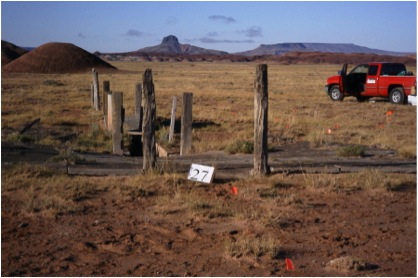Project Title: Assessment and Remediation of Pesticides on Indian Lands |
Client: Bureau of Indian Affairs, Multi-year MATOC for Environmental Services |

OAS has conducted numerous environmental service jobs on Indian lands in the southwestern United States spanning environmental compliance, hazardous waste characterizations, solid waste transfer station design, database development, groundwater monitoring, site assessments, and remediations. OAS was selected as one of three nation-wide Indian-owned Multiple Award Task Order contractors for a BIA Washington, D.C. Division Contract. This contract spanned 5 years and was a Basic Ordering Agreement which is very similar to the Corps of Engineers Multi-year IDCs. Serial task orders were assigned to delineated contamination at both the Hopi and Navajo sheep dip vats and to execute the remediation planning, engineering and cost estimating, and finally the field remediation of the sites.
Contamination Delineation and Remediation Associated with Sheep Dip Vats in the Hopi and Navajo Nations
OAS conducted field investigations at former sheep dip vat sites on the Navajo and Hopi reservation lands in Arizona and New Mexico. Activities were split into four phases. Phase I was initial sampling of 83 sites on the Navajo Reservation and 10 sites on the Hopi Nation. Samples were taken at approximately 12 standard areas at each site associated with the dipping operations. Activities included: soil sampling, analysis for Toxaphene, site characterization, and report preparation. Sampling was performed in Level C respiratory protection. 43 of the sites had soil concentrations exceeding the action limit of 40 mg/Kg Toxaphene.
Phase II consisted of supplemental sampling at the 43 sites exceeding the action limits, to fully define the extent of contamination. Samples were taken radially outward from the “hot spots” identified in Phase I. Again, Toxaphene concentrations were quantified. Two full-time field crews submitted over 2,500 samples for chemical analysis.
Phase III was remediation planning, using those analyses, the volumes of soil requiring remediation were calculated. OAS developed several treatment alternatives and performed an Engineering Evaluation/ Cost Analysis on the alternative methods.
Phase IV was the active remediation of 25 sites using bio-cells, off-site disposal or off-site incineration techniques. Activities primarily involved soil removal, construction of on-site bio-cells, treatment of the soil materials, monitoring of the bio-cells and closure & re-vegetation of the sites.
OAS Provided Technical Specialists for:
- -Site Health and Safety
- -Development of Project Plans : Community Relations Plan, Field Sampling Plan, Health & Safety Plan, Quality Assurance Plan, Remedial Action Plan, Laboratory QA/QC & SOPs
- -Obtaining the proper permits and approvals for all stages of operations.
- -Location of remote sheep dip vats & geo-referencing samples
- -Sampling, manifesting & shipping of samples to sub-contracted Analytical Laboratory
- -QA/QC Review of analytical laboratory results
- -Coordination with Agency for Toxic Substances & Disease Registry regarding action levels and remediation strategies
- -Defined extent of contamination in soils and waters
- -Developed remediation strategies & provided Engineering Evaluation/Cost Analysis on alternatives
- -Provided BIA basis on which to selected the preferred remediation strategy at each site
- -Performed the site remediation
- -Performed site monitoring of worker and environmental surrounds
- -Performed post remediation monitoring
- -Prepared closure reports for BIA and regulatory authorities.